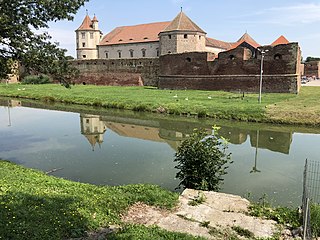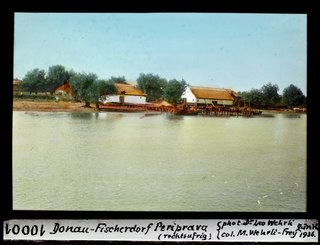Related Research Articles

The Sighet Prison, located in the city of Sighetu Marmației, Maramureș County, Romania, was used by Romania to hold criminals, prisoners of war, and political prisoners. It is now the site of the Sighet Memorial Museum, part of the Memorial of the Victims of Communism.

Gherla Prison is a penitentiary located in the Romanian city of Gherla, in Cluj County. The prison dates from 1785; it is infamous for the treatment of its political inmates, especially during the Communist regime. In Romanian slang, the generic word for a prison is "gherlă", after the institution.

Făgăraș Citadel is a historic monument in Făgăraș, Brașov County, Romania.

Râmnicu Sărat Prison is a former prison located in Râmnicu Sărat, Buzău County, Romania. The building is listed as a historic monument by Romania's Ministry of Culture and Religious Affairs.

The Periprava labor camp was a labor camp operated by the Romanian communist regime, part of the Brăila Pond labor camps. The camp, located near the village of Periprava in the Danube Delta, held up to 2,000 prisoners. According to a study done by the International Centre for Studies into Communism, 8.23% of political prisoners in Communist Romania did time at Periprava. In the literature on communist prisons and camps in Romania, the Periprava labor camp is described as one of the harshest places of imprisonment. In view of the extremely severe detention and work regime, sheer terror, and high mortality, the camp is known among former detainees as a true "death camp".

Jilava Prison is a prison located in Jilava, a village south of Bucharest, Romania.
The lead mine prison camps in Communist Romania operated in the early to mid-1950s at three sites in Maramureș County: Baia Sprie, Cavnic, and along the Nistru valley.
The Brăila Pond labor camps were a series of labor camps operated by the Romanian communist regime in the 1950s and ‘60s, around the Great Brăila Island.

The Caransebeș Prison was a prison in Caransebeș, Romania.
Ocnele Mari Prison was a prison located in Ocnele Mari, Vâlcea County, Romania.

Târgu Ocna Prison is a prison located in Târgu Ocna, Bacău County, Romania.
Botoșani Prison is a prison located in Botoșani, Romania.

Craiova Prison is a prison located in Craiova, Romania.
Brașov Prison was a prison located in Brașov, Romania.
Cluj Prison was a prison located in Cluj, Romania.

Văcărești Prison was a prison located in Bucharest, Romania.
Dumbrăveni Prison was a prison located in Dumbrăveni, Romania.
Galați Prison is a prison located in Galați, Romania.
Suceava Prison was a prison located in Suceava, Romania.
Iași Prison is a prison located in Iași, Romania.
References
- Muraru, Andrei (2008). Dicționarul penitenciarelor din România comunistă: 1945–1967 (in Romanian). Institutul de Investigare a Crimelor Comunismului în România. Iași: Polirom. ISBN 978-973-46-0893-5. OCLC 297531689.